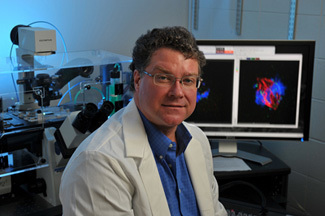
A breakthrough in the laboratory of Kevin Vaughan, associate professor of biological sciences at the University of Notre Dame, will assist researchers in understanding cell cycle regulation. The group identified a novel protein that is regulated by the mitotic kinase Aurora B, an important factor in mitosis, or cell division.
In addition to cancers with a genetic origin, such as colon and breast cancers, mistakes in mitosis are considered a leading cause of spontaneous cancers.
The research was published this month in Molecular Biology of the Cell, the official journal of the American Society for Cell Biology. The discovery was made possible by collaboration with the Notre Dame Integrated Imaging Facility and the Notre Dame Mass Spectrometry and Proteomics Facility.
Graduate students James Kasuboski and Jason Bader in Vaughan’s lab conducted most of the study, collaborating with Bradley Smith, director of the Integrated Imaging Facility, and William Boggess, director of the Mass Spectrometry and Proteomics Facility. Using cutting-edge equipment, the researchers were able to visualize chromosomes during the process of alignment and to detect errors in alignment when Aurora B activity was abnormal. New instruments in the mass spectrometry and proteomics facility allowed the investigators to identify the substrate for Aurora B kinase, a protein critical to chromosome signaling during this process.
The published research identifies this novel protein and its role in coupling the process of alignment with accurate chromosome segregation. Undergraduate biology majors Meghan Morrissey and Michael Winding also contributed to the project.
Vaughan, who is on the steering committee of both facilities, says the combination gave a critical advantage to the Notre Dame researchers compared to those who have access to only one of the technologies. The facilities became fully functional about 18 months ago, and the research is one of the first to demonstrate the power of the facilities.
“Other scientists don’t have access to these sophisticated instruments, which makes this type of work very difficult,” Vaughan says, adding that acquisition of the facilities started three years ago with funds from the Office of the Provost to support research infrastructure. “We coupled imaging with mass spectrometry, both in state-of-the-art facilities. It’s an example of what can happen with other projects.”
Contact: Kevin Vaughan, 574-631-3733, Kevin.T.Vaughan.4@nd.edu
Originally published by at newsinfo.nd.edu on August 18, 2011.
